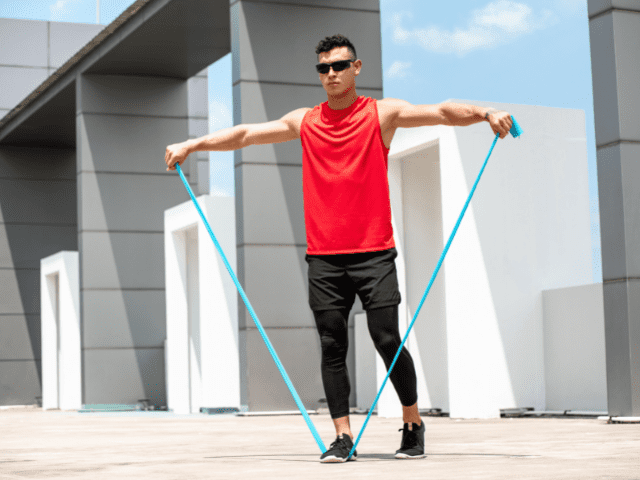11 Dumbbell Lateral Raise Alternatives For Growing Shoulders
The Dumbbell Lateral Raise is an extremely popular supplemental exercise for shoulder development. It’s easy to learn, beginner-friendly and is one of the most effective exercises for focusing on the lateral deltoid.
However, sometimes you may find yourself needing an alternative for Dumbbell Lateral Raises.
Maybe you don’t have dumbbells or maybe you’re just looking to add some variety to your workouts.
Whatever the reason, if you’re looking for an exercise to substitute for DB Lateral Raise then you’re in the right place. I’m about to share with you 11 of my favorite lateral raise alternatives including a few different lateral raise variations and lifts using different equipment.
Alternatives to Dumbbell Lateral Raise
The first few alternatives I have are really more variations than they are alternatives. They focus on how you can still do lateral raises, just with a slight variation or with a different piece of equipment.
The second half of the list focuses on true alternative exercises, but ones that are still going to emphasize working the medial head of the deltoids – something lateral raises do as well as any movement in the weight room.
Use Weight Plates

If you’re really wanting to do Dumbbell Lateral Raises, but you just don’t have dumbbells available to you there may be a really simple solution that you maybe haven’t thought of.
Use Weight Plates. If you have weight plates, you can easily use 5, 10 and even 25-pound plates in place of dumbbells.
Depending on the type of plate and design you may have to get a little creative with how you hold the plates (when in doubt 2 fingers through the center cap generally always works), but weight plates can be a perfect substitute for dumbbells and you can do lateral raises with really no variation at all.
Dead Stop Lateral Raise

The Dead Stop, or Pause Lateral Raises, is a simple, but effective way to increase the time under tension of the exercise. Increasing time under tension increases muscle recruitment and ultimately, hypertrophy.
The starting position stays the same and the arm raise stays the same. The only difference is taking a complete one-second (or longer) pause at the very top position. It won’t take long before you’ll notice the effects of that pause and you’ll most likely need a lighter weight for Dead Stop Lateral Raise versus a regular lateral raise.
Single Arm Lateral Raise

If what you’re looking for is a slight variation to add some variety to your workout plan, then Single Arm Lateral Raises might be a good alternative.
Just like it sounds, Single Arm Lateral Raises involves lifting one dumbbell at a time instead of two. Not only does this allow you to really focus on each arm individually, but the core becomes much more active and involved to stabilize the body.
Cable Lateral Raise

If you don’t have dumbbells, but you have access to a cable machine (in other words, you’re at a hotel gym) then Cable Lateral Raises can make a substitution for Dumbbell Lateral Raises.
Lower the pulley all the way to the bottom and attach a single handle attachment. Reach down and across your body to grab the attachment. Now, perform lateral raises one arm at a time lifting up and away from the machine.
Don’t rush. Stay in control of each rep, especially on the eccentric portion (lowering back down).
Machine Lateral Raise

Personally, I’ve never been a huge fan of the Nautilus-style lateral raise machine, but they keep making them and putting them in big commercial gyms so somebody out there is using them.
A lateral raise machine comes in slightly different forms, but for the most part they involve sitting down and have circular pads on each side of you. Adjust the pad so it falls on your arm just above the elbow. As you raise your arms out to the side the pad will roll up your arm just a bit.
Just like with any variation of lateral raise, control the weight and don’t rush through the reps.

Tired of coming up with your own workouts? But don’t want to pay an arm and a leg?
I post workouts 5 days a week right here. (Did I mention they’re free?)
Band Lateral Raise

The final lateral raise variation uses resistance bands. If you’re lifting at home, chances are much greater that you have a few resistance bands in your gym than one of the bulky machines I just mentioned.
For Band Lateral Raises, use a thinner band and stand on one side of it. Now, reach across the body and grab the band (similar starting position to a cable machine). Lift the band out and away from the foot that is standing on the band up to shoulder height.
If you have a squat rack (or something similarly sturdy) you can also loop the band around the rack so you won’t need to stand on it. This is my preferred way of setting up for Band Lateral Raises because I feel I can adjust easier to make the lift more comfortable and less awkward.
Note: If your resistance band is long enough (and thin enough) you may be able to lift both arms at once instead of one arm at a time (as pictured above).
Dumbbell Shoulder Press

My first suggestion for a lateral raise alternative that doesn’t involve actually doing lateral raises is Dumbbell Shoulder Presses. Dumbbell Shoulder Press is still going to really focus on the medial head of the deltoids, but it also comes with additional benefits.
Dumbbell Shoulder Press works of three heads of the delt and because you can press much more weight than you can side raise, they’re much more effective at building strength.
They can be performed from a standing position or seated (I prefer standing). Bring both dumbbells up to the shoulders and then begin pressing to full extension overhead and then lowering back down to the shoulders each rep.
Front Press

Front Press, or Barbell Overhead Press, is one of the best exercises period for developing upper body strength. It is essentially the barbell version of the Dumbbell Shoulder Press. If you don’t have dumbbells (or even if you do), Front Raises are an excellent option for developing strong, broad shoulders.
Two quick tips for Front Press:
First, as soon as the bar crosses the top of your head, ‘pull’ your head through so that you finish the rep with the bar directly over your ears. Second, stagger your stance. Place your feet hip width apart in a toe to heel relationship instead of having them side by side, feet shoulder width apart.
Pulling your head through and staggering your stance are both effective ways to help keep you from overarching the low back. Combine those two techniques with bracing your core as you press and you should be able to Front Press without straining your low back.
Landmine Press

Landmine Presses are one of the most unique ways you can add some variety to your workout routine. And before you go scrolling right past because you don’t have a landmine attachment, here is how you can make your own with just a tennis ball.
To do Landmine Presses, load the open up of the barbell with weight and then grab the end of the barbell with both hands and raise it into a starting position at shoulder height. Remove one hand and then press one arm at a time.
You can also actually do a Landmine Lateral Raise by grabbing the end of the barbell and doing a lateral raise motion. I’ve never been a huge fan of it personally because I think the movement is a bit awkward, but the option is available if you want to give it a try.
Barbell Upright Row

Barbell Upright Rows are often thought of as a back exercise and often don’t get enough credit for how well they work your shoulders. Yes, Barbell Upright Rows heavily emphasize the upper trapezius, but they also work the deltoids and the biceps.
To do Barbell Upright Rows, grab a bar with an overhand grip about shoulder-width apart. I recommend experimenting with your grip width to see what feels most comfortable on your shoulders when you row.
Brace the core and pull the bar straight up to just under the chin. Lower back down under control and repeat. Make sure not to ‘rock’ or ‘swing’ the weight up. If you can’t row the bar with proper form, lower the weight.
Pro Tip: Some lifters find Barbell Upright Row to be uncomfortable bordering on painful to the shoulder joints. If you find this is the case, you can Dumbbell Upright Rows instead or just nix the upright row completely and stick to one of the other lateral raise alternatives.
Big 30
The Big 30 is one of my favorite shoulder complexes. It’s easy to learn, extremely efficient and, most importantly, will absolutely light your shoulders on fire.
The Big 30 is a giant set of Dumbbell Front Raises, Lateral Raises and Rear Delt Raises.
Each of the three lifts focuses on a different part of the deltoid muscle:
- Front Raise – Anterior Deltoid
- Lateral Raise – Lateral Deltoid
- Rear Delt Raise – Posterior Deltoid
Grab a lighter weight than you would normally use for lateral raises. Start with 10 Dumbbell Front Raises, followed immediately by 10 Lateral Raises and then finish with 10 Rear Delt Raises. The key to the Big 30 is doing all three exercises back-to-back-to-back with no rest in between and without setting the dumbbells down in between each lift.
Big 30s are outstanding toward the end of a workout as a shoulder finisher to torch your shoulders.

Get Shredded… For Free
Get a free workout Monday through Friday, posted right here on Horton Barbell. These workouts are designed to help you get strong, in shape and look great at the beach!
Final Thoughts
The Dumbbell Lateral Raise is an excellent exercise for developing strong shoulders, but sometimes lateral raises just aren’t an option. You may not have the proper equipment available to you or at other times you might just be looking to add some variety to your shoulder routine.
In these situations, you’ll need a lateral raise alternative and I hope that one of the exercises I’ve listed here fits what you were looking for.

